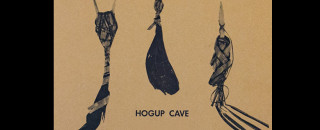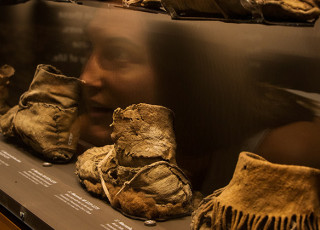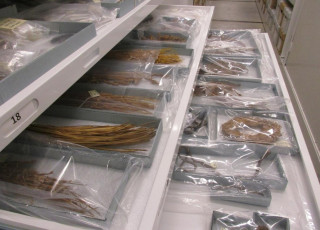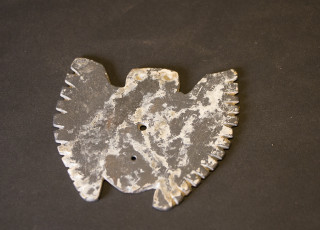Fremont Horned Figurines – What are They?
By Michael Mozdy
Every nook and cranny in the museum holds something interesting – not just because we know the complete story behind these objects, but more often because they engage our imaginations and intellect as we try to piece together what they mean.
For example, on a wall in the Ancient Peoples Gallery on Level 3, next to the Dry Caves Learning Lab, is a small display of objects excavated from Hogup Cave, in Utah’s Hogup Mountains.
Hogup Cave was excavated by a team of archaeologists from the University of Utah in the late 1960s. Remarkably, they found sixteen distinct layers of occupation, and by radiocarbon dating, determined that it was home to humans all the way back to 6400 B.C. They found hearths in most levels, a large excavated pit (likely for garbage), and nearly 10,000 fascinating artifacts.
Here’s a short list of artifacts they found: 396 pottery sherds, 5,450 chipped stone items (projectile points, blades, scrapers, drills, shaft smoothers, milling stones, pestles, incised stones, etc.), 269 worked bone, antler, horn, and shell artifacts, 719 hide artifacts (moccasins, robes, etc.), 1,242 pieces of cordage, 160 pieces of basketry, 491 pieces of worked wood and reed (atlatl, arrows, etc.). You get the point: the history of humans found in the cave is pretty incredible.
Among this cornucopia of artifacts were ten anthropomorphic figurines. “Anthropomorphic” means that they took the form of a human figure.
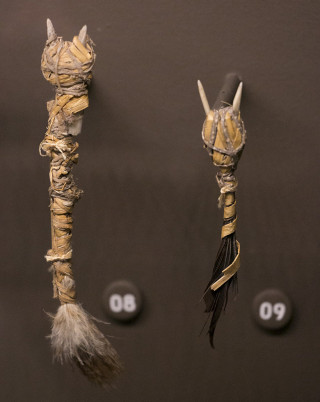
Two of the Hogup Cave figurines, displayed at NHMU.
The report states the following:
Ten artifacts are composed of bundles of wrapped plant fiber, either sagebrush bark or reed. All have projecting "horns" at one end, made of bone splinters, twigs, or cactus spines. Four specimens have feathers attached to the ends opposite the horns.
These figurines are visually striking and fairly rare. Horned figures in Fremont culture aren't necessarily rare, however. Fremont rock art commonly portrays horned human figures, and these little figurines are beautiful, three-dimensional manifestations of what we see in the rock art.
They are so beautiful, in fact, that as I walked by this installation at the museum, I had to stop and stare. To me, they look as well-crafted and evocative as anything I’d see at the Arts Festival. The fibers wrapped around the head and body physically hold the figure together and seem to hold an essence within. The slight twist to the bodies amplifies this lifelike effect and hints that they could have been a dynamic force in these humans’ lives. The feathers at the bottom lighten the figures, suggesting that they are more suited to flight than lying down. They are the perfect size for holding in your hand, grasping or twisting between your fingers, or even affixing to a necklace. Finally, the horns project sharply upward in a way that only briefly resembles ears and more firmly evokes something animalistic or from the spirit world.
Because of how they were found – buried in layers of sediment – we have no clues as to how they were used by these people. However, part of the museum experience is to ask yourself these questions. What do you know about the Fremont peoples? They were resourceful hunter-gatherers, bound together in communities, great makers of tools and art… What does your imagination conjure? Could these figurines have been ceremonial, personal, spiritual, playful? We have no concrete answer for this, at least not until someone finds another archaeological clue to move this story forward.
Until then, come visit the museum and bring the fact gathering side of your brain as well as your imagination – you need them both.
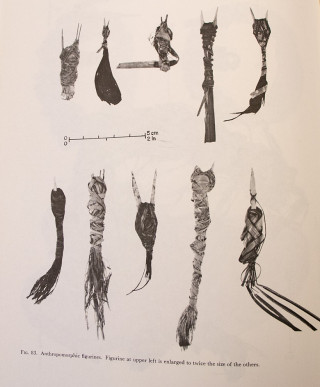
All ten figurines found in Hogup Cave.
Michael Mozdy is a Digital Science Writer for The Natural History Museum of Utah, a part of the University of Utah in Salt Lake City. Our mission is to illuminate the natural world and the place of humans within it. In addition to housing outstanding exhibits for the public, NHMU is a research museum. Learn more.
